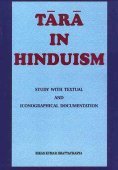Shaktism, Śaktism: 3 definitions
Introduction:
Shaktism means something in Hinduism, Sanskrit, the history of ancient India. If you want to know the exact meaning, history, etymology or English translation of this term then check out the descriptions on this page. Add your comment or reference to a book if you want to contribute to this summary article.
In Hinduism
Shaivism (Shaiva philosophy)
Source: Himalayan Academy: Dancing with SivaŚāktism (=Śākta) refers to the “doctrine of power”.—The religion followed by those who worship the Supreme as the Divine Mother—Śakti or Devī—in Her many forms, both gentle and fierce. Śāktism is one of the four primary sects of Hinduism. Śāktism’s first historical signs are thousands of female statuettes dated ca 5500 BCE recovered at the Mehrgarh village in India. In philosophy and practice, Śāktism greatly resembles Śaivism, both faiths promulgating, for example, the same ultimate goals of advaitic union with Śiva and mokṣa. But Śāktas worship Śakti as the Supreme Being exclusively, as the dynamic aspect of Divinity, while Śiva is considered solely transcendent and is not worshiped.
There are many forms of Śāktism, with endless varieties of practices which seek to capture divine energy or power for spiritual transformation. Geographically, Śāktism has two main forms, the Śrīkula “family of the Goddess Śrī (or Lakṣmī),” which respects the brāhminical tradition (a mainstream Hindu tradition which respects caste and purity rules) and is strongest in South India; and the Kālīkula, “family of Kālī,” which rejects brāhminical tradition and prevails in Northern and Eastern India.

Shaiva (शैव, śaiva) or Shaivism (śaivism) represents a tradition of Hinduism worshiping Shiva as the supreme being. Closely related to Shaktism, Shaiva literature includes a range of scriptures, including Tantras, while the root of this tradition may be traced back to the ancient Vedas.
India history and geography
Source: archive.org: Social Life In Medieval RajasthanŚaktism in Rājasthān.—From both archaeological and epigraphic evidences it is clear that the mother-goddess was worshipped in Rājasthān in one form or another from the early age to the end of our period. Her chief forms that have come to light from the terra-cottas or inscriptional or archival references of early period are of varied characters, indicating her valour, anger and benevolence, which are manifested in Mātridevī, Mahiśāsuramardini, Durgā, Pārvatī, Yogeśvarī, Dadhimati, Kṣemakarī, Araṇyavāsinī, Vasundarā, Astamātrikā, Rādhikā, Lakṣmī, Bhagavatī, Nandā, Sarasvatī, Kātyāyinī, Vaṭayakṣiṇī, Ambikā, Kālī, Sañcikā and Yogeśvarī.
Source: What is India: Inscriptions of the ŚilāhārasŚaktism (Devī-worship) during the reign of the Śilāhāra dynasty (r. 765-1215 A.D.).—Some temples of goddesses are also mentioned in Śilāhāra inscriptions. The most famous of them was the temple of Mahālakṣmī at Kolhāpur. Her temple is a star-shaped triple shrine, with Mahālakṣmī in the central garbhagṛha, and Mahākālī and Mahāsarasvatī in the shrine to her right and left respectively. It had already become famous as a well-known Śakta-pīṭha. These Śilahāras were her fervent devotees. They believed that they had obtained their kingdom by her grace; for they state in their grants that they had secured her gracious boon.

The history of India traces the identification of countries, villages, towns and other regions of India, as well as mythology, zoology, royal dynasties, rulers, tribes, local festivities and traditions and regional languages. Ancient India enjoyed religious freedom and encourages the path of Dharma, a concept common to Buddhism, Hinduism, and Jainism.
See also (Relevant definitions)
Full-text (+366): Bhairava, Indus Valley, Vastuyaga, Caritra, Cakri, Savitra, Jrimbhaka, Shesha, Mriga, Ditya, Apa, Aryaman, Pilapicchaka, Katyayini, Guha, Sharva, Putana, Vivasvan, Indrajaya, Apavatsaka.
Relevant text
Search found 16 books and stories containing Shaktism, Śaktism, Saktism; (plurals include: Shaktisms, Śaktisms, Saktisms). You can also click to the full overview containing English textual excerpts. Below are direct links for the most relevant articles:
Diaspora of Bhuta (Daiva) worshipping cult—India and Indonesia (by Shilpa V. Sonawane)
Part 6.3 - Association with Tantra < [Chapter 4 - Inter-Disciplinary Analysis]
Part 6.1 - Shaktism in India and Indonesia—Goddess Adi Parashakthi < [Chapter 4 - Inter-Disciplinary Analysis]
Part 6.2 - Shakti and Shiva < [Chapter 4 - Inter-Disciplinary Analysis]
Vedic influence on the Sun-worship in the Puranas (by Goswami Mitali)
Part 6 - Non-Vedic Religious System < [Chapter 3 - General Characteristics of the Purāṇic Religion and its Link with the Vedic Tradition]
Part 9 - Non-Vedic Elements in the Purāṇic Religion < [Chapter 3 - General Characteristics of the Purāṇic Religion and its Link with the Vedic Tradition]
Part 2 - Pre-Purāṇic Religious Systems Prevalent in India < [Chapter 3 - General Characteristics of the Purāṇic Religion and its Link with the Vedic Tradition]
Historical Elements in the Matsya Purana (by Chaitali Kadia)
Religion and Rituals: Śākta < [Chapter 5 - Cultural history in the Matsya-Purāṇa]
Lakulisha-Pashupata (Philosophy and Practice) (by Geetika Kaw Kher)
The Lakulisa-Pasupata activity in Orissa < [Chapter 2 - Spread and Transition]
Lord Hayagriva in Sanskrit Literature (by Anindita Adhikari)
The Matsya Purana (critical study) (by Kushal Kalita)
Part 3 - Śāktism: The Devī-cult < [Chapter 4 - Religious aspects of the Matsyapurāṇa]
Related products
